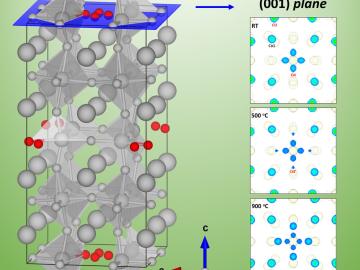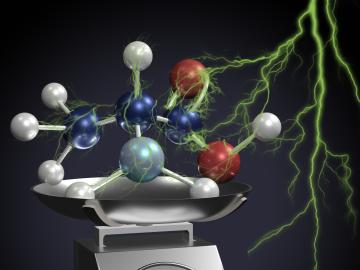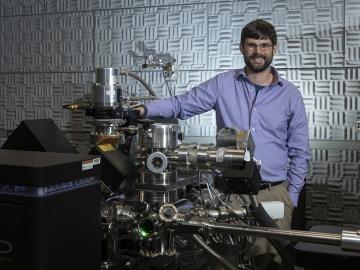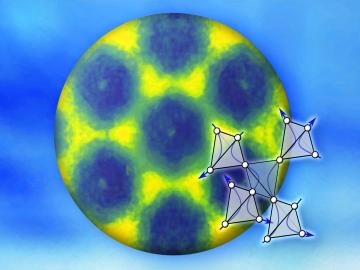
Filter News
Area of Research
- Advanced Manufacturing (7)
- Biological Systems (1)
- Biology and Environment (43)
- Computational Engineering (1)
- Computer Science (2)
- Energy Frontier Research Centers (1)
- Energy Science (62)
- Fusion and Fission (6)
- Fusion Energy (3)
- Isotope Development and Production (1)
- Isotopes (18)
- Materials (106)
- Materials Characterization (1)
- Materials for Computing (16)
- Materials Under Extremes (1)
- Mathematics (1)
- National Security (16)
- Neutron Science (73)
- Nuclear Science and Technology (10)
- Quantum information Science (2)
- Supercomputing (38)
- Transportation Systems (1)
News Type
News Topics
- (-) Bioenergy (65)
- (-) Clean Water (23)
- (-) Composites (26)
- (-) Cybersecurity (26)
- (-) Element Discovery (1)
- (-) Frontier (20)
- (-) Isotopes (38)
- (-) Materials Science (105)
- (-) Molten Salt (8)
- (-) Nanotechnology (47)
- (-) Neutron Science (91)
- 3-D Printing/Advanced Manufacturing (95)
- Advanced Reactors (27)
- Artificial Intelligence (60)
- Big Data (37)
- Biology (74)
- Biomedical (41)
- Biotechnology (21)
- Buildings (46)
- Chemical Sciences (57)
- Computer Science (119)
- Coronavirus (34)
- Critical Materials (25)
- Education (3)
- Emergency (1)
- Energy Storage (88)
- Environment (126)
- Exascale Computing (17)
- Fossil Energy (2)
- Fusion (35)
- Grid (45)
- High-Performance Computing (55)
- Hydropower (8)
- Irradiation (2)
- ITER (6)
- Machine Learning (37)
- Materials (105)
- Mathematics (8)
- Mercury (9)
- Microelectronics (1)
- Microscopy (39)
- National Security (38)
- Nuclear Energy (63)
- Partnerships (35)
- Physics (46)
- Polymers (28)
- Quantum Computing (19)
- Quantum Science (47)
- Security (20)
- Simulation (27)
- Space Exploration (13)
- Statistics (2)
- Summit (32)
- Transportation (74)
Media Contacts

Scientists have tested a novel heat-shielding graphite foam, originally created at Oak Ridge National Laboratory, at Germany’s Wendelstein 7-X stellarator with promising results for use in plasma-facing components of fusion reactors.
OAK RIDGE, Tenn., Feb. 12, 2019—A team of researchers from the Department of Energy’s Oak Ridge and Los Alamos National Laboratories has partnered with EPB, a Chattanooga utility and telecommunications company, to demonstrate the effectiveness of metro-scale quantum key distribution (QKD).

OAK RIDGE, Tenn., Feb. 8, 2019—The Department of Energy’s Oak Ridge National Laboratory has named Sean Hearne director of the Center for Nanophase Materials Sciences. The center is a DOE Office of Science User Facility that brings world-leading resources and capabilities to the nanoscience resear...

Oak Ridge National Laboratory scientists analyzed more than 50 years of data showing puzzlingly inconsistent trends about corrosion of structural alloys in molten salts and found one factor mattered most—salt purity.

A University of South Carolina research team is investigating the oxygen reduction performance of energy conversion materials called perovskites by using neutron diffraction at Oak Ridge National Laboratory’s Spallation Neutron Source.

OAK RIDGE, Tenn., Jan. 31, 2019—A new electron microscopy technique that detects the subtle changes in the weight of proteins at the nanoscale—while keeping the sample intact—could open a new pathway for deeper, more comprehensive studies of the basic building blocks of life.

Jon Poplawsky, a materials scientist at the Department of Energy’s Oak Ridge National Laboratory, develops and links advanced characterization techniques that improve our ability to see and understand atomic-scale features of diverse materials

Researchers used neutron scattering at Oak Ridge National Laboratory’s Spallation Neutron Source to investigate bizarre magnetic behavior, believed to be a possible quantum spin liquid rarely found in a three-dimensional material. QSLs are exotic states of matter where magnetism continues to fluctuate at low temperatures instead of “freezing” into aligned north and south poles as with traditional magnets.

A team of scientists has for the first time measured the elusive weak interaction between protons and neutrons in the nucleus of an atom. They had chosen the simplest nucleus consisting of one neutron and one proton for the study.

Scientists at the Department of Energy’s Oak Ridge National Laboratory have created a recipe for a renewable 3D printing feedstock that could spur a profitable new use for an intractable biorefinery byproduct: lignin.


